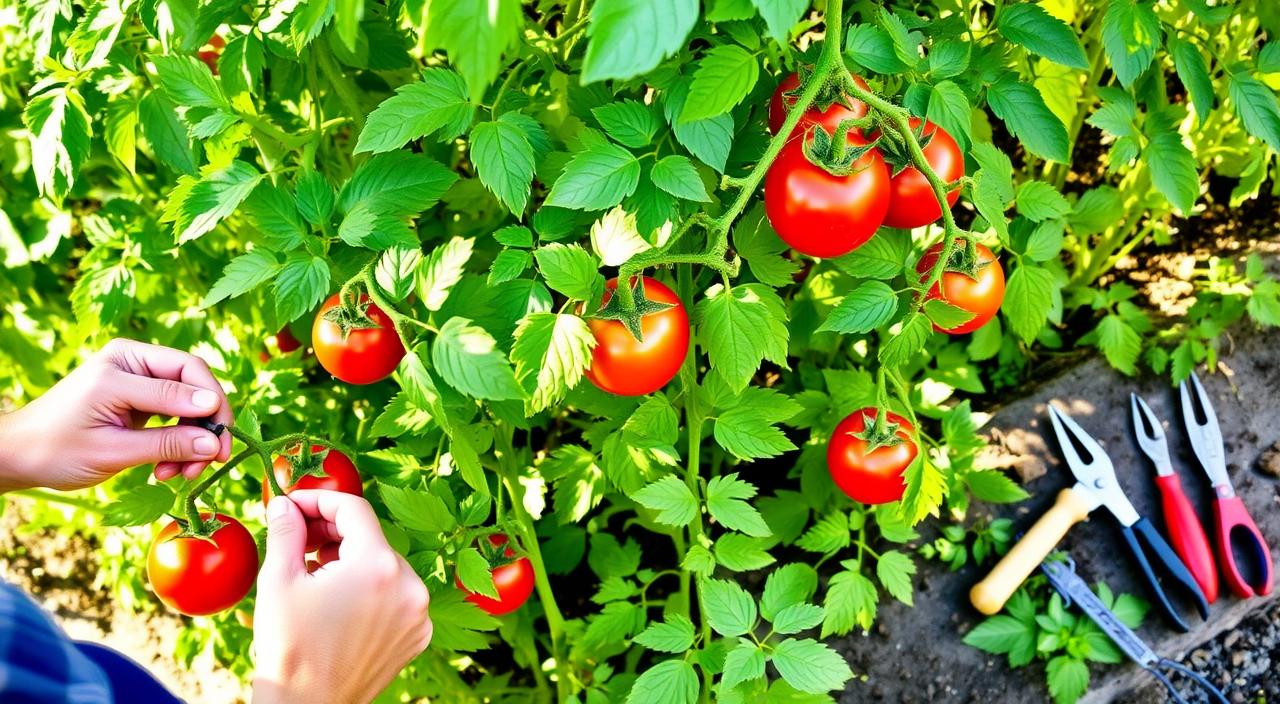I’ve found that pruning tomato plants is key for a great harvest. These plants grow lots of leaves and not as many fruits. By pruning, I get more tomatoes and bigger, tastier ones. It’s easy and quick, but it makes a big difference.
By cutting back on leaves, your tomato plants work harder on growing big, tasty fruit. I’ll give you six easy tips for pruning your tomato plants. These tips will help you grow a garden full of healthy, productive plants.
Key Takeaways
- Pruning tomato plants can lead to fewer fruits but larger, higher-quality tomatoes.
- Removing excess foliage allows plants to direct more energy towards fruit production.
- Proper pruning techniques can help prevent diseases and improve airflow around the plants.
- Indeterminate tomato varieties benefit the most from regular pruning.
- Pruning young tomato plants promotes healthier growth and increased yields.
Understanding Tomato Plant Growth Habits
Growing tomatoes requires knowing the different growth habits of tomato varieties. They are either determinate or indeterminate. This affects how they should be pruned and cared for.
Determinate vs. Indeterminate Varieties
Determinate tomato plants grow to about 4-5 feet tall and then stop. They produce all their fruit in 4-6 weeks. Indeterminate plants, however, keep growing and producing fruit all season until frost.
Common Indeterminate Tomato Varieties
- Sungold
- Sweet 100
- Juliet
- Big Boy
- Early Girl
- Big Beef
- Jet Star
- Brandywine
- Cherokee Purple
Indeterminate varieties like Sungold, Sweet 100, and Brandywine benefit from pruning. This helps them grow better and produce bigger, healthier fruit.
“Pruning tomato plants can lead to fewer fruits but larger in size, beneficial for shorter-season climates.”
Knowing how tomato plants grow is key to pruning and caring for them. It helps in growing tomatoes well in your garden.
When to Start Pruning Tomato Plants
Pruning is key for growing tasty tomatoes. Start pruning a few months after moving them to the garden. This is when the first flower buds open.
Tomatoes start flowering and making fruit in June or July. They grow suckers, or extra stems, that you should cut off. This helps the plant focus on making big, healthy tomatoes instead of too much foliage.
Prune your tomato plants in the morning, after the dew has dried. This prevents diseases that can spread from pruning wet plants. Cut off suckers when they are 2 to 4 inches long, the best size for removal.
How often you prune depends on the tomato type. Determinate plants stop growing once they reach a height. Indeterminate plants need pruning every couple of weeks as they keep growing.
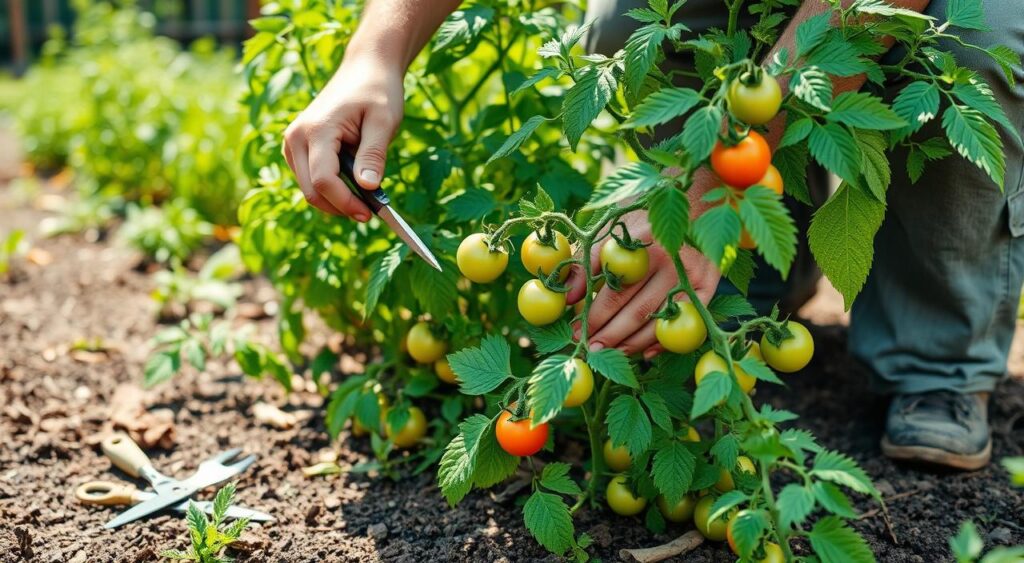
Knowing when and how to prune your tomato plants leads to a great harvest. Consistent pruning keeps your plants healthy and productive.
Removing Suckers for Better Airflow
Keeping a tomato plant healthy and productive means understanding its growth and using smart pruning. It’s key to remove suckers that grow where the main stem meets the leaf branches. This action boosts air flow and stops diseases that love moist spots.
Identifying and Removing Tomato Suckers
Spotting tomato suckers is simple once you know where to look. They appear in the leaf axils, where the main stem meets the branches. These shoots can take energy from the plant, hurting the growth of fruit-bearing branches.
- Identify suckers early, around 1/2 inch in size, for easier removal.
- Pinch off suckers with your thumb and forefinger or use a pair of clean, sharp pruners.
- Aim to remove most, if not all, of the suckers you see on your tomato plants.
By removing suckers, you improve air flow around the plant. This cuts down the risk of diseases like early and late blight, and fungi that love moist places. The fruit will also be bigger and better quality.
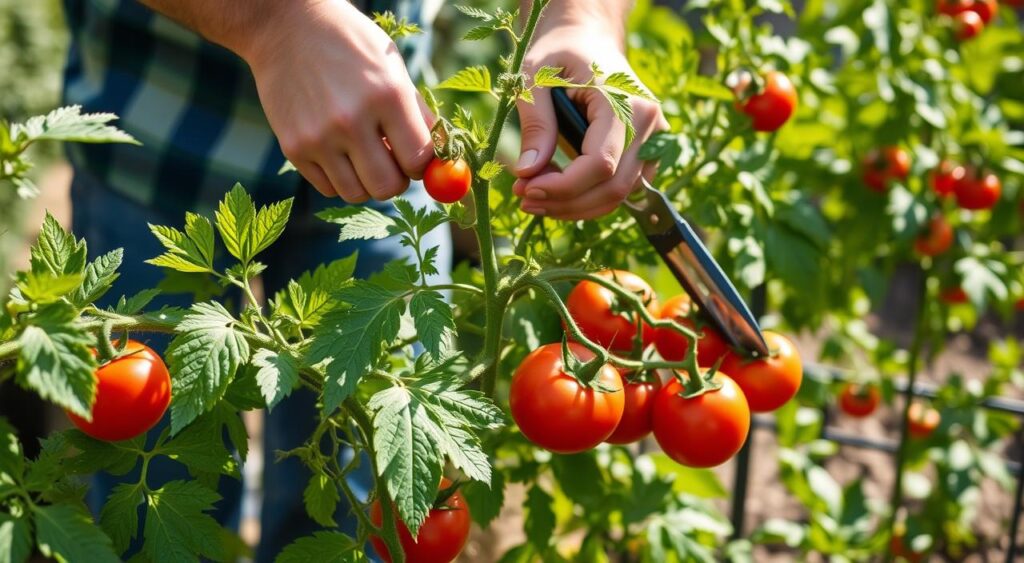
“Pruning tomato suckers can result in plants having more fruit, but smaller in size.”
Tomato plants have different pruning needs based on their type. Indeterminate varieties, like cherry tomatoes, do well with regular sucker removal. This keeps them in check and boosts fruit production. Determinate varieties, such as Roma and Celebrity, are naturally more compact and might need less pruning.
Pruning for Optimal Tomato Plant Health
Proper pruning is key for healthy, productive tomato plants. It helps with air flow, light, and focuses energy on fruit. This makes the tomatoes bigger and tastier.
Removing Lower Leaves
Take off the lower 6 to 12 inches of leaves on the main stem. This stops diseases like blight and mildew from reaching the plant. It’s a simple way to keep your tomatoes healthy all season.
Thinning Fruit Clusters
For varieties like ‘Celebrity,’ ‘Jet Star,’ and ‘Brandywine,’ thinning fruit clusters makes the tomatoes bigger and better. Just take out some of the fruit, leaving the biggest ones. This way, the plant works harder on fewer fruits, giving you bigger, juicier tomatoes.
Pruning your tomato plants is easy but important. Remove lower leaves, thin fruit clusters, and don’t prune too much. This keeps your plants healthy and gives you lots of tasty tomatoes.
“By pruning your tomato plants, you can ensure they stay healthy, productive, and free from disease-causing bacteria and fungi.”
Proper Pruning Techniques
Getting your tomato plant to thrive is more than just planting and watering. It’s also about pruning correctly. Pruning can make the plant open to diseases. So, keeping things clean is key.
Maintaining Clean Tools
Always make sure your pruning tools are clean before you start. Wash your hands well with soap and water or use a hand sanitizer to avoid spreading diseases. Clean the pruners with a mix of diluted bleach or rubbing alcohol between cuts. Keeping your tools clean and yourself germ-free is vital for disease prevention.
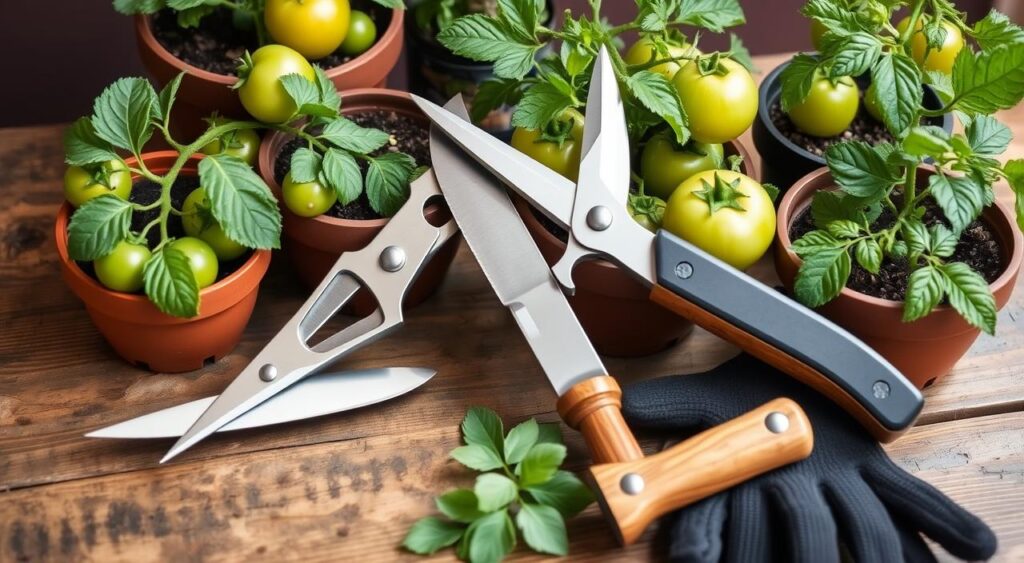
Not cleaning your tools can spread diseases like bacterial spot and blight. Disinfecting your tools helps keep your tomato plants healthy and boosts your harvest.
“Proper pruning and tool hygiene are essential for the long-term health and productivity of your tomato plants.”
Remember, tomato plant pruning techniques, clean pruning tools, and good pruning hygiene are all important. They help keep your tomato garden healthy and stop disease.
How to Prune Tomato Plants
Pruning your tomato plants is key to healthy growth and lots of tomatoes. As a gardener, I’ve learned that pruning makes a big difference. It boosts the health and yield of my garden. Let’s explore how to prune your tomato plants right.
When to Start Pruning Tomato Plants:
- Start pruning when your tomato plants are about 12 to 15 inches tall.
- When you first transplant them, remove blossoms to help the plant grow a strong root system.
Removing Lower Leaves and Suckers:
- Take off any branches with leaves that touch the ground. These are more likely to get diseases or pests.
- Find the suckers in the “armpits” of the plant and cut them off.
- Keep cutting off lower leaves and suckers as the plant grows.
- Start removing lower leaves when they turn yellow.
Maintaining Pruning Techniques:
- Use clean, germ-free pruning tools to stop spreading diseases.
- Prune in the early morning on a dry day for better healing.
- Don’t take off more than one-third of the plant’s leaves to avoid stressing it out.
| Pruning Technique | Benefit |
|---|---|
| Removing Suckers | Improves air circulation and reduces disease risks |
| Thinning Fruit Clusters | Encourages larger fruit size and earlier ripening |
| Maintaining Clean Tools | Prevents the spread of diseases between plants |
By using these pruning tips, you’ll grow healthy, productive tomato plants. Enjoy your gardening journey!
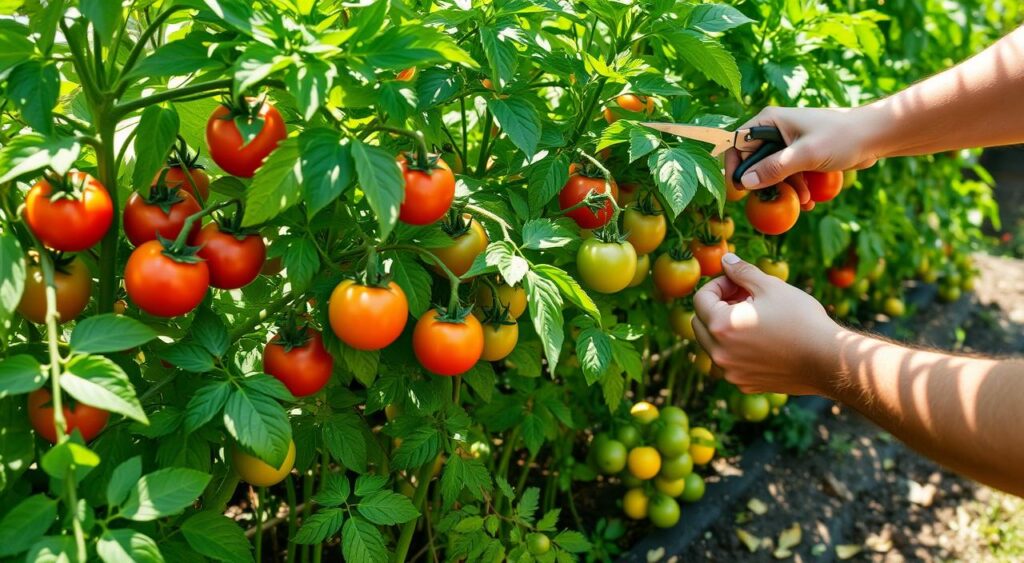
Additional Tomato Pruning Tips
Pruning your tomato plants has many benefits. It improves airflow, fights diseases, and boosts fruit production. There are more tips to enhance your tomato care.
Rooting Pruned Suckers
Don’t throw away pruned tomato suckers! You can grow new tomato plants from them. Just put the suckers in a glass of water to start rooting.
Soon, you’ll see roots grow. When the roots are long enough, move the sucker to soil. Treat it like any other tomato plant.
Dealing with Fasciated Blossoms
Sometimes, you’ll see fasciated tomato blossoms. These look like clusters of flowers stuck together. They’re interesting but can harm the plant.
They take too much energy, making the fruit poor quality. Pinch off these blossoms to help the plant focus on growing better tomatoes.
Using these tips can make your tomato plants healthier and more productive. This leads to a great harvest. Proper pruning is key for tomato plant care and vegetable gardening success.
Conclusion
Pruning tomato plants is key to getting a healthy, productive harvest. Knowing how determinate and indeterminate varieties grow helps me prune better. By removing suckers and lower leaves, I improve airflow and cut down on disease. This lets the plant focus on growing bigger, tastier fruit.
These pruning tips are great for both backyard and large-scale tomato gardens. They make a big difference in how well my tomato plants do. By pruning and caring for my plants, I can expect a great tomato plant pruning harvest. And I’ll get to enjoy the fresh, tasty fruits of my labor.
Adding these healthy tomato plants and higher tomato yields methods to my vegetable gardening routine is smart. It helps me get the most out of my tomato plants. And I’ll have plenty of delicious, homegrown tomatoes all season long.
FAQ
Q: What are the benefits of pruning tomato plants?
A: Pruning tomato plants helps you get more tomatoes per plant. It also makes the fruit bigger and better quality. Plus, it improves airflow and lowers the risk of diseases.
Q: How do I identify determinate and indeterminate tomato varieties?
A: Determinate tomatoes stop growing at a certain height and produce fruit all at once. Indeterminate tomatoes keep growing and make fruit all season.
Q: When is the best time to start pruning tomato plants?
A: Prune tomato plants when they reach 12-15 inches tall. This is usually a few months after you put them in the garden.
Q: How do I identify and remove tomato suckers?
A: Tomato suckers appear in the “armpits” where the main stem meets the leaf branches. You can pinch or cut them off with clean tools to help with airflow and stop diseases.
Q: What other pruning techniques can I use to maintain healthy tomato plants?
A: To keep tomato plants healthy, remove lower leaves and thin out fruit clusters. Also, keep your pruning tools clean to stop diseases from spreading.
Q: How can I use the pruned tomato suckers?
A: You can root pruned tomato suckers in water and then transplant them. This way, you can grow new tomato plants.


